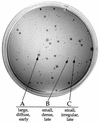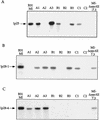Clonal polymorphism of Borrelia burgdorferi strain B31 MI: implications for mutagenesis in an infectious strain background
- PMID: 11895980
- PMCID: PMC127854
- DOI: 10.1128/IAI.70.4.2139-2150.2002
Clonal polymorphism of Borrelia burgdorferi strain B31 MI: implications for mutagenesis in an infectious strain background
Abstract
A major obstacle to studying the functions of particular gene products in the mouse-tick infectious cycle of Borrelia burgdorferi has been an inability to knock out genes in pathogenic strains. Here, we investigated conditions for site-directed mutagenesis in B31 MI, the low-passage-number, infectious B. burgdorferi strain whose genome was sequenced. We inactivated several plasmid and chromosomal genes in B31 MI and determined that clones carrying these mutations were not infectious for mice. However, we found extensive heterogeneity among clones and mutants derived from B31 MI based on colony phenotype, growth rate, plasmid content, protein profile, and transformability. Significantly, several B31 MI clones that were not subjected to mutagenesis but that lacked particular plasmids also exhibited defects at various stages in the infectious cycle. Therefore, the high degree of clonal polymorphism within B31 MI complicates the assessment of the contributions of individual genes to the observed phenotypes of the mutants. Our results indicate that B31 MI is not an appropriate strain background for genetic studies in infectious B. burgdorferi, and a well-defined isogenic clone is a prerequisite for targeted mutagenesis. To this end, we derived several wild-type clones from B31 MI that were infectious for mice, and gene inactivation was successful in one of these clones. Due to the instability of the genome with in vitro propagation, careful monitoring of plasmid content of derived mutants and complementation of inactivated genes will be crucial components of genetic studies with this pathogen.
Figures







Similar articles
-
Population dynamics of a heterogeneous Borrelia burgdorferi B31 strain in an experimental mouse-tick infectious cycle.Wien Klin Wochenschr. 2002 Jul 31;114(13-14):557-61. Wien Klin Wochenschr. 2002. PMID: 12422601
-
Genome-Wide Mutagenesis in Borrelia burgdorferi.Methods Mol Biol. 2018;1690:201-223. doi: 10.1007/978-1-4939-7383-5_16. Methods Mol Biol. 2018. PMID: 29032547
-
Plasmid stability during in vitro propagation of Borrelia burgdorferi assessed at a clonal level.Infect Immun. 2003 Jun;71(6):3138-45. doi: 10.1128/IAI.71.6.3138-3145.2003. Infect Immun. 2003. PMID: 12761092 Free PMC article.
-
Genetic studies in Borrelia burgdorferi.Wien Klin Wochenschr. 1998 Dec 23;110(24):859-62. Wien Klin Wochenschr. 1998. PMID: 10048165 Review.
-
Transposon mutagenesis as an approach to improved understanding of Borrelia pathogenesis and biology.Front Cell Infect Microbiol. 2014 May 20;4:63. doi: 10.3389/fcimb.2014.00063. eCollection 2014. Front Cell Infect Microbiol. 2014. PMID: 24904839 Free PMC article. Review.
Cited by
-
Borrelia burgdorferi infection modifies protein content in saliva of Ixodes scapularis nymphs.BMC Genomics. 2021 Mar 4;22(1):152. doi: 10.1186/s12864-021-07429-0. BMC Genomics. 2021. PMID: 33663385 Free PMC article.
-
OspC is potent plasminogen receptor on surface of Borrelia burgdorferi.J Biol Chem. 2012 May 11;287(20):16860-8. doi: 10.1074/jbc.M111.290775. Epub 2012 Mar 20. J Biol Chem. 2012. PMID: 22433849 Free PMC article.
-
The BBA01 protein, a member of paralog family 48 from Borrelia burgdorferi, is potentially interchangeable with the channel-forming protein P13.J Bacteriol. 2006 Jun;188(12):4207-17. doi: 10.1128/JB.00302-06. J Bacteriol. 2006. PMID: 16740927 Free PMC article.
-
DNA Methylation by Restriction Modification Systems Affects the Global Transcriptome Profile in Borrelia burgdorferi.J Bacteriol. 2018 Nov 26;200(24):e00395-18. doi: 10.1128/JB.00395-18. Print 2018 Dec 15. J Bacteriol. 2018. PMID: 30249703 Free PMC article.
-
Elimination of channel-forming activity by insertional inactivation of the p13 gene in Borrelia burgdorferi.J Bacteriol. 2002 Dec;184(24):6811-9. doi: 10.1128/JB.184.24.6811-6819.2002. J Bacteriol. 2002. PMID: 12446631 Free PMC article.
References
-
- Bono, J. L., K. Tilly, B. Stevenson, D. Hogan, and P. Rosa. 1998. Oligopeptide permease in Borrelia burgdorferi: putative peptide-binding components encoded by both chromosomal and plasmid loci. Microbiology 144:1033-1044. - PubMed
Publication types
MeSH terms
Substances
Grants and funding
LinkOut - more resources
Full Text Sources
Other Literature Sources
Molecular Biology Databases

